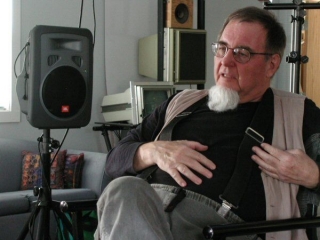Date: 7 March 2004 | Season: Vasulka Video
VASULKA VIDEO: LECTURE
Sunday 7 March 2004, at 3pm
London Candid Arts Trust
Woody Vasulka: Lecture on Sound and Image Relationships in Early Video Art
Initially, they identified two properties peculiar to video. Both audio and video signals are composed of electronic waveforms. Since sound can be used to generate video, and vice versa, one of the first pieces of equipment the Vasulkas bought was an audio synthesiser. Many of their tapes illustrate this relationship – one type of signal determines the form of the other. Their second interest entailed construction of the video frame. Because timing pulses control the stability of the video raster to create the “normal” image we are accustomed to, viewers rarely realise – unless their TV set breaks down – that the video signal is actually a frameless continuum. This fact, discovered accidentally, fascinated the Vasulkas.
“At that time, I was totally obsessed with this idea that there was no single frame anymore. I come from the movies, where the frame was extremely rigid, and I understood that electronic material has no limitation within its existence. It only has limitation when it reaches the screen because the screen itself is a rigid time structure.” —Woody Vasulka in Afterimage, 1983
PROGRAMME NOTES
VASULKA VIDEO: LECTURE
Sunday 7 March 2004, at 3pm
London Candid Arts Trust
WOODY VASULKA
Since the mid-1970s, Woody Vasulka’s work has focused on a rich articulation of the syntactical potential of electronic imaging. After producing a pioneering body of tapes in collaboration with Steina in the early 1970s, he has since undertaken a sophisticated exploration of the narrative and metaphorical meaning of technological images. Vasulka’s development of an expressive image-language has evolved from a rigorous deconstruction of the materiality of the electronic signal, through experiments with new technologies of digital manipulation, to the application of these imaging codes to narrative strategies.
The culmination of this investigation, Art of Memory (1987), is one of the major works in video. In this lushly textured, haunting essay, Vasulka applies a highly evolved imaging grammar to a metaphorical discourse of collective memory, history, and the meaning of recorded images – envisioned as a spectacular memory-theatre inscribed upon the landscape of the American Southwest.
In his early investigations of the vocabulary of such devices as the Digital Image Articulator, Vasulka emphasised the dialogue between artist and machine, as manifested in real-time creativity and process-oriented experimentation. Through digital manipulation, he continues to explore the malleability and objectification of the electronic image as a means of rendering a complex inventory of rhetorical devices. With the fantastical ‘electronic opera’ The Commission (1983), Vasulka began to apply these codes to the development of narrative and metaphorical strategies, an inquiry that has dominated his later work.
Woody Vasulka was born in Brno, Czechoslovakia in 1937. He studied at the School of Industrial Engineering in Brno and the Academy of Performing Arts Faculty of Film and Television in Prague. With Steina, he has won numerous awards and grants; their collaborative works have been exhibited internationally. His individual works have been shown in numerous exhibitions, at festivals and institutions including the International Center of Photography, New York; Los Angeles Contemporary Exhibitions (LACE); Carnegie Museum of Art, Pittsburgh; and the Whitney Museum of American Art Biennial, New York. Woody Vasulka lives in Santa Fe, New Mexico.
Back to top
